Geoarchaeological Characterisation of Sites of Iberian and Roman Cordoba Using LiDAR Data Acquisitions
Abstract
1. Introduction
1.1. Geography and Geomorphology of Cordoba and the Guadalquivir River Valley
1.2. Application of LiDar Data to the Ancient Geomorphology of Iberian and Roman Cordoba
- Demonstrate the usefulness of LiDAR-PNOA data processing applied to the historic area of Cordoba occupied by the pre-Roman city, the Roman city and the medieval city. This could be replicated in other superimposed historic cities in Spain, because the open data sources of IGN are available for the entire national territory.
- Combine these results with the geomorphological background and archaeological knowledge of the city in order to trace the orographic history of the city’s urban development.
2. Materials and Methods
3. Results
3.1. Geomorphological Layout of the Guadalquivir River Valley in Cordoba
3.2. Geomorphological Reconstruction of the Iberian Cordoba Site
3.3. Geomorphological Reconstruction of the Roman Cordoba Site
3.4. Geomorphological Reconstruction of a lost Hypothetical Meander of the Guadalquivir
3.5. Occupation of the Old Riverbed by the Enlargement of the Roman City
4. Discussion
4.1. The Location of Iberian Cordoba (Approx. 300–100 B.C.)
4.2. The Location of Cordoba in the Roman Republic Period (169–168 B.C.)
4.3. A Lost Meander of the Hypothetically Recovered River
4.4. Results on the Enlargement of Cordoba in the Roman Imperial period (45 B.C.–100. A.C.)
5. Conclusions
- The shape of the quaternary terraces in the urban centre of the city has been specified and a three-dimensional image has been obtained in a level of detail that geological maps are unable to provide.
- The geomorphological and volumetric layout of the hill where the Iberian Cordoba settlement was located has been identified.
- An old course of the Guadalquivir River has been identified, the limits of which were located in the Iberian city and the Roman city.
- Hypothetically, the presence of an old meander of the river, which is currently clogged, has been proposed.
Funding
Acknowledgments
Conflicts of Interest
References
- Hatzopoulos, J.N.; Stefanakis, D.; Georgopoulos, A.; Tapinaki, S.; Volonakis, P.; Liritzis, I. Use of various surveying technologies to 3D digital mapping and modelling of cultural heritage structures for maintenance and restoration purposes: The Tholos in Delphi. Mediterr. Archaeol. Archaeom. 2017, 17, 311–336. [Google Scholar] [CrossRef]
- Cihan Altuntas, S.; Süleyman, K. Image based methods for surveying heritage of masonry arch bridge with the example of dokuzunhan in Konya, Turkey. Sci. Cult. 2017, 3, 13–20. [Google Scholar] [CrossRef]
- Kaimaris, D. Ancient theaters in greece and the contribution of geoinformatics to their macroscopic constructional features. Sci. Cult. 2018, 4, 9–25. [Google Scholar] [CrossRef]
- Adara López-López, A.; Cerrillo Cuenca, E. Arqueología Aérea y Fuentes de Datos Libres. Posibilidades y Lte. 2016, 1, 181–193, (LiDAR-PNOA for archaeology of and other Spanish databases). [Google Scholar]
- Instituto Geográfico Nacional. Available online: www.ign.es (accessed on 7 May 2019).
- Chase, A.S.Z.; Chase, D.Z.; Chase, A.F. LiDAR for Archaeological Research and the Study of Historical Landscapes. In Sensing the Past; Masini, N., Soldovieri, F., Eds.; Geotechnologies and the Environment 16; Springer: Cham, Switzerland, 2017; pp. 89–100. [Google Scholar] [CrossRef]
- Masini, N.; Coluzzi, R.; Lasaponara, R. On the Airborne Lidar Contribution in Archaeology: From Site Identification to Landscape Investigation, Laser Scanning, Theory and Applications. In Laser Scanning, Theory and Applications; Wang, C.-C., Ed.; IntechOpen: Rijeka, Croatia, 2011; pp. 263–290. [Google Scholar] [CrossRef]
- Carrero-Pazos, M.; Vilas Estévez, B.; Romaní Fariña, E.; Abel Rodríguez Casal, A. La necrópolis del Monte de Santa Mariña revisitada: Aportaciones del Lidar aéreo para la cartografía megalítica de Galicia. Gallaecia 2015, 33, 39–57. [Google Scholar] [CrossRef][Green Version]
- Cerrillo Cuenca, E. An approach to the automatic surveying of prehistoric barrows through LiDAR. Quat. Int. 2017, 435, 135–145. [Google Scholar] [CrossRef]
- Costa-García, J.M.; Casal García, R. Fotografía aérea histórica, satelital moderna y lidar aéreo en algunos recintos militares romanos de Castilla y León. Portvgalia 2015, 36, 143–158. [Google Scholar]
- Costa García, J.M. Presencia militar romana en La Chana (Castrocalbón, León). Nailos EstudiosInterdisciplinares de Arqueología 2016, 3, 47–85. [Google Scholar]
- Berrocal-Rangel, L.; Paniego Díaz, P.; Ruano, L.; Manglano Valcárcel, G.R. Aplicaciones LiDAR a la topografía arqueológica: El Castro de Irueña (Fuenteguinaldo, Salamanca). Cuadernos de Prehistoria y Arqueología Universidad Autónoma de Madrid 2017, 43, 195–215. [Google Scholar] [CrossRef]
- Blanco-Rotea, R.; Güimil-Fariña, A.; Mañana-Borrazás, P.; Fonte, J. Using airborne laser scanning and historical aerial photos to identify fortifications in the Minho Valley, Northwest Iberian Peninsula. In Three Dimensions of Archaeology, Proceedings of the XVII UISPP World Congress, Burgos, Spain, 1–7 September 2014; Kamermans, H., de Neef, W., Piccoli, C., Posluschny, A.G., Scopigno, R., Eds.; Volume 7/Sessions A4b and A12; Archaeopress: Oxford, UK, 2016; pp. 111–120. [Google Scholar]
- Cordero Ruiz, T.; Cerrillo Cuenca, E.; Pereira, C. Detección de un nuevo campamento romano en las inmediaciones de Mérida mediante tecnología LiDAR. Saguntum 2017, 49, 197–201. [Google Scholar] [CrossRef]
- Monterroso Checa, A. Remote Sensing and Archaeology from Spanish LiDAR PNOA: Identifying the roman the Amphitheatre of the roman city of Torreparedones. Mediterr. Archaeol. Archaeom. 2017, 1, 22–56. [Google Scholar] [CrossRef]
- Devereux, B.J.; Amable, G.S.; Crow, P.; Cliff, A.D. The potential of airborne LiDAR for detection of archaeological features under woodland canopies. Antiquity 2005, 79, 648–660. [Google Scholar] [CrossRef]
- Sittler, B. Revealing Historical Landscapes by Using Airborne Laser Scanning. A 3-D Modell of Ridge and Furrow in Forests near Rastatt (Germany). In Proceedings of Natscan, Laser-Scanners for Forest and Landscape Assessment—Instruments, Processing Methods and Applications, Freiburg, Germany, 3–6 October 2004; Thies, M., Koch, B., Spiecker, H., Weinacker, H., Eds.; International Archives of Photogrammetry and Remote Sensing; Volume XXXVI, Part 8/W2; International Society for Photogrammetry and Remote Sensing: Freiburg, Germany, 2004; pp. 258–261. [Google Scholar]
- Bini, M.; Fabiani, F.; Pappalardo, M.; Schuldenrein, J. Special issue of Geoarchaeology: Urban geoarchaeology in the Mediterranean Basin. Geoarchaeology 2018, 33, 3–12. [Google Scholar] [CrossRef]
- Fontana, A.; Ronchi, L.; Rossato, S.; Mozzi, P. Lidar-derived dems for geoarchaeological investigations in alluvial and coastal plains. Alp. Mediterr. Quat. 2018, 31, 209–212. [Google Scholar]
- Cremaschi, M.; Storchi, P.; Perego, A. Geoarchaeology in urban context: The town of Reggio Emilia and river dynamics during the last two millennia in Northern Italy. Geoarchaeology 2018, 33, 52–66. [Google Scholar] [CrossRef]
- Butzer, K.W.; Butzer, E.; Love, S. Urban geoarchaeology and environmental history at the Lost City of the Pyramids, Giza: Synthesis and review. J. Archaeol. Sci. 2013, 40, 3340–3366. [Google Scholar] [CrossRef]
- Amato, V.; Ciarcia, S.; Rossi, A.; Santoriello, A. The urban geoarchaeology of Benevento (Southern Italy): A tool for the evaluation of archaeological potential. Geoarchaeology 2018, 33, 100–111. [Google Scholar] [CrossRef]
- Torres Márquez, M. Paisajes del Valle medio del Guadalquivir cordobés: Funcionalidad y cambios. Revista de Estudios Regionales 2013, 96, 135–180. [Google Scholar]
- Ramírez Copeiro, J.; Castellò Montorí, R.; Armengot de Pedro, J. Mapa Geológico de la Hoja nº 923 (Córdoba). Mapa Geológico de España a Escala 1:50,000 Segunda Serie (MAGNA). 1973, Volume 923, pp. 16–37. Available online: http://info.igme.es/cartografiadigital/datos/magna50/memorias/MMagna0923.pdf (accessed on 7 May 2019).
- Martínez del Olmo, C.; Riaza Molina, C.; Torrescusa Villaverde, S. Descenso eustáticomessiniense en una cuenca atlántica. El cañón submarino del río Guadalquivir (SO de España) Geogaceta 1996, 20, 138–141. [Google Scholar]
- Ruiz Lara, D.; Ortiz, R.; Carmona, S.; Soriano, P. El medio físico. In El Anfiteatro Romano de Córdoba y su Entorno Urbano; Vaquerizo, D., Murillo, J., Eds.; Análisis arqueológico, vol. I. (ss. I-XIII d.C.); Junta de Andalucía: Sevilla, España, 2010; pp. 33–42. [Google Scholar]
- Liñán Guijarro, E.; Ruiz Bueno, M. Las terrazas fluviales de Córdoba y su influencia en el emplazamiento de la ciudad en época prerromana y romana. Cuaternario y Geomorfología 2018, 32, 9–22. [Google Scholar] [CrossRef]
- Instituto Geológico y Minero de España. Available online: www.igme.es (accessed on 7 May 2019).
- León Pastor, E. La Secuencia Cultural de la Corduba Prerromana a Través de sus Complejos Cerámicos; Universidad de Córdoba: Córdoba, Spain, 2007. [Google Scholar]
- Murillo, J.F. Nuevos trabajos arqueológicos en Colina de los Quemados: El sector del teatro de la Axarquía. (Parque Cruz Conde, Córdoba). Anuario Arqueológico de Andalucía 1992, 3, 188–199. [Google Scholar]
- Murillo, J.F.; Vaquerizo, D. Corduba prerromana. In Colonia Patricia Corduba, una reflexión arqueológica; León, P., Ed.; Universidad de Córdoba: Córdoba, Spain, 1996; pp. 37–47. [Google Scholar]
- Arqueocórdoba. Available online: http://www.arqueocordoba.com/recursos/bibliografia/ (accessed on 7 May 2019).
- Centro de Descargas CNIG. Available online: http://centrodedescargas.cnig.es/CentroDescargas/index.jsp (accessed on 7 May 2019).
- Mihaela, P.; Codruţa, B.M.; Gabriel, E.; Daniela, P. Hydrographic Basins Analysis Using Digital Terrain Modelling. IOP Conf. Ser. Mater. Sci. Eng. 2017, 245, 062034. [Google Scholar] [CrossRef]
- Sistema de Información Geográfica de Excavaciones Arqueológicas de Córdoba (SIGEAC). Available online: http://www.arqueocordoba.com/sigeac/ (accessed on 7 May 2019).
- Uribelarrea, D.; Benito, G. Fluvial changes of the Guadalquivir River during the Holocene in Córdoba (Southern Spain). Geomorphology 2008, 100, 14–31. [Google Scholar] [CrossRef]
- Núñez Granados, M.A.; Recio Espejo, J.M. Tributary Alluvial Fan–Response to Base-level Fall by Axial Fluvial Incision: A Case in the Guadalquivir Valley (Córdoba, Spain). Open Geogr. J. 2014, 6, 9–12. [Google Scholar] [CrossRef][Green Version]
- Baena Escudero, R.; Díaz del Olmo, F. Cuaternario Aluvial de la Depresión del Guadalquivir: Episodios geomorfológicos y cronología paleomagnética. Geogaceta 1994, 5, 102–104. [Google Scholar]
- Rodríguez Ramírez, A.; Cáceres, J.M.; Rodríguez, J.; Clemente, L.; Cantano, M. Geomorfología de las terrazas fluviales del tramo bajo del Guadalquivir. Implicaciones evolutivas. Geogaceta 1997, 21, 183–186. [Google Scholar]
- Godoy Delgado, F.; Morena López, J.A. Prospección Arqueológica Superficial de Urgencia en los terrenos afectados por la red de distribución de gas natural a industrias de Córdoba. Anuario Arqueológico de Andalucía 1989, 3, 119–126. [Google Scholar]
- Ventura, A.; León, P.; Márquez, C. Roman Córdoba in the light of recent archaeological research. In The Archeology of Early Roman Baetica; Keay, S., Ed.; Supplementary Series; JRA: Portsmouth, NH, USA, 1998; Volume 29, pp. 87–107. [Google Scholar]
- Carrasco Gómez, I.; Murillo Redondo, J.F.; Rodero Pérez, S.; González Virseda, M.; Garriguet Mata, J.A. Informe-memoria de la I.A.U. en el Paseo de la Ribera (1999–2001). I. Sector de la Puerta del Puente. Anuario Arqueológico de Andalucía 2000, 3, 283–298. [Google Scholar]
- Ventura, A.; y Monterroso-Checa, A. Estudio sucinto de la campaña de excavación 1998–2000 en el teatro romano de Córdoba: La terraza media oriental. Anuario Arqueológico de Andalucía 2000, 3, 427–446. [Google Scholar]
- Courault, C. Les Remparts de Cordue. Une Investigation Archéologique Depuis l’Antiquité Jusqu’à L’époque Médiévale. Ph.D. Thesis, University of Córdoba, Córdoba, Spain, 2014. [Google Scholar]
- Liébana Sánchez, M. Actividad Arqueológica Preventiva en el solar sito en la c/ Paseo de la Ribera nº 19, Córdoba. Anuario Arqueológico de Andalucía 2006, 3, 1192–1199. [Google Scholar]
- García Benavente, R. Sondeo arqueológico y análisis de estructuras emergentes. Calleja del posadero nº21 de Córdoba. Anuario Arqueológico de Andalucía 2008, 3, 1351–1360. [Google Scholar]
- Palomino Guerrero, D. Informe-Memoria de la Intervención Arqueológica de Urgencia en el solar sito en calle Agustin Moreno, 21 de Córdoba. Anuario Arqueológico de Andalucía 2002, 3, 294–302. [Google Scholar]
- Rodríguez Gutiérrez, A.J. A.A.P. en C./Consolación, nº 13, Córdoba. Anuario Arqueológico de Andalucía 2005, 3, 516–528. [Google Scholar]
- Vargas, S.; Carrillo, J.R. Intervención Arqueológica en el Hospital Santa María de losHuérfanos (C/Agustín Moreno nº 3, Córdoba). Anuario Arqueológico de Andalucía 2001, 3, 275–284. [Google Scholar]
- Monterroso-Checa, A. Resultados de la IAU realizada en el solar nº 7 de la C/ Enrique Romero de Torres esquina Paseo de La Ribera de la ciudad de Córdoba. Anuario Arqueológico de Andalucía 2002, 3, 457–469. [Google Scholar]
- López Rey, N. Informe sobre la Intervención Arqueológica de Urgencia y el seguimiento en el solar nº. 19 de la Calle Badanas, esq Consolación de la ciudad De Córdoba. Anuario Arqueológico de Andalucía 1993, 3, 125–131. [Google Scholar]
- Monterroco-Checa, A. Ex Theatro Cordubensi. La Vida del Monumento y la Producción de Cerámicas Africanas en el Valle del Baetis; Serie Monografías de Arqueología Cordobesa; Universidad de Córdoba: Córdoba, Spain, 2005; Volume 10. [Google Scholar]
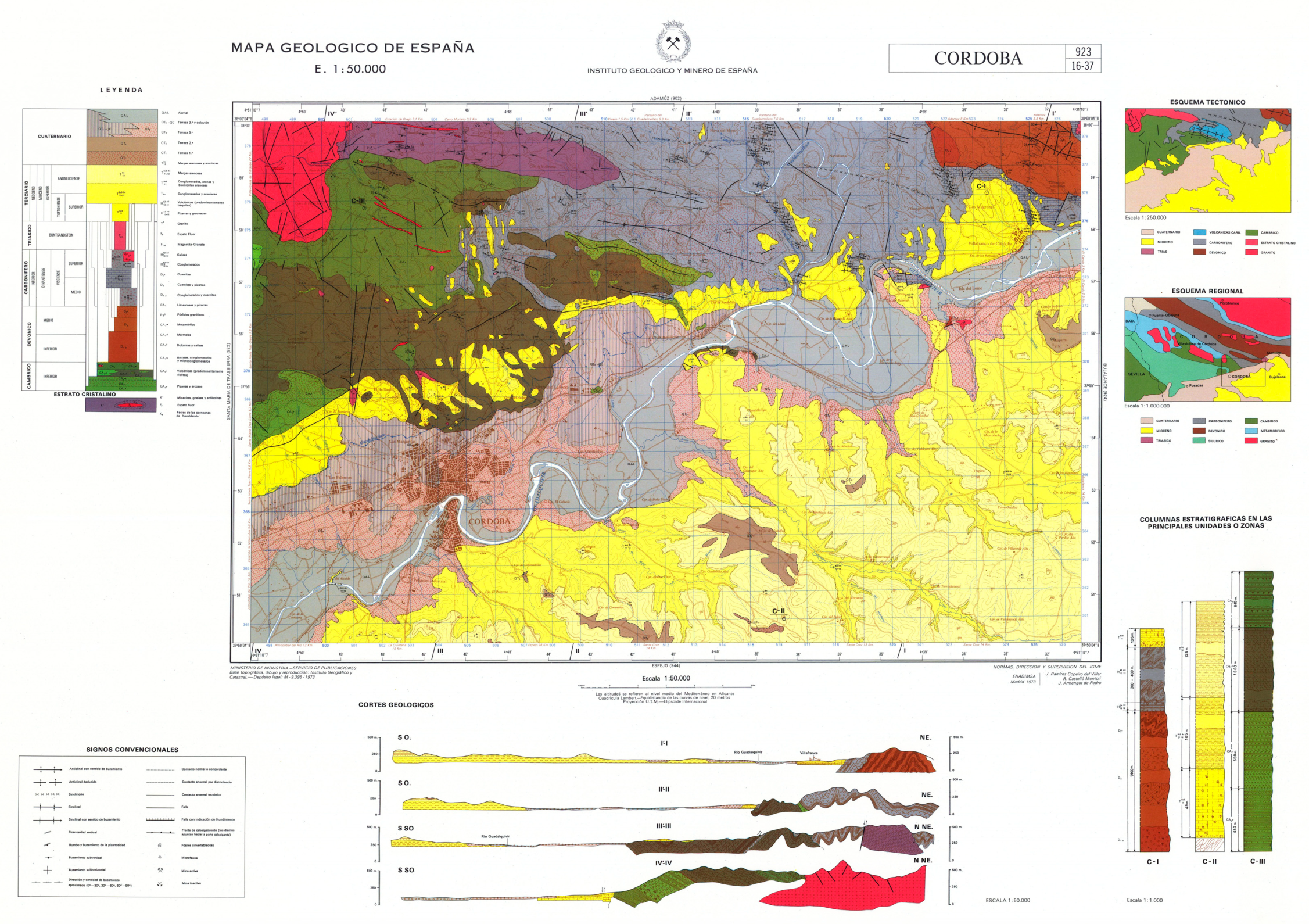
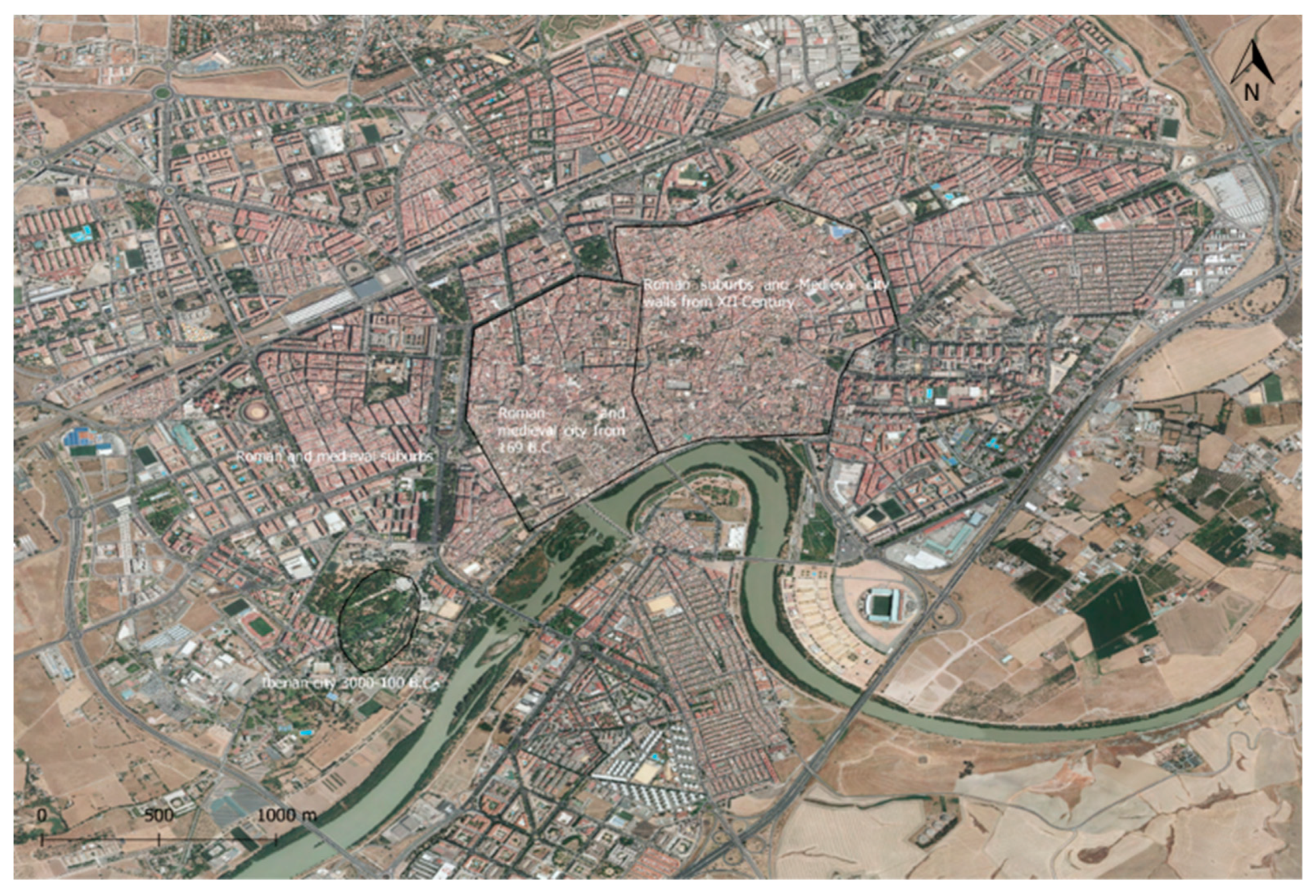
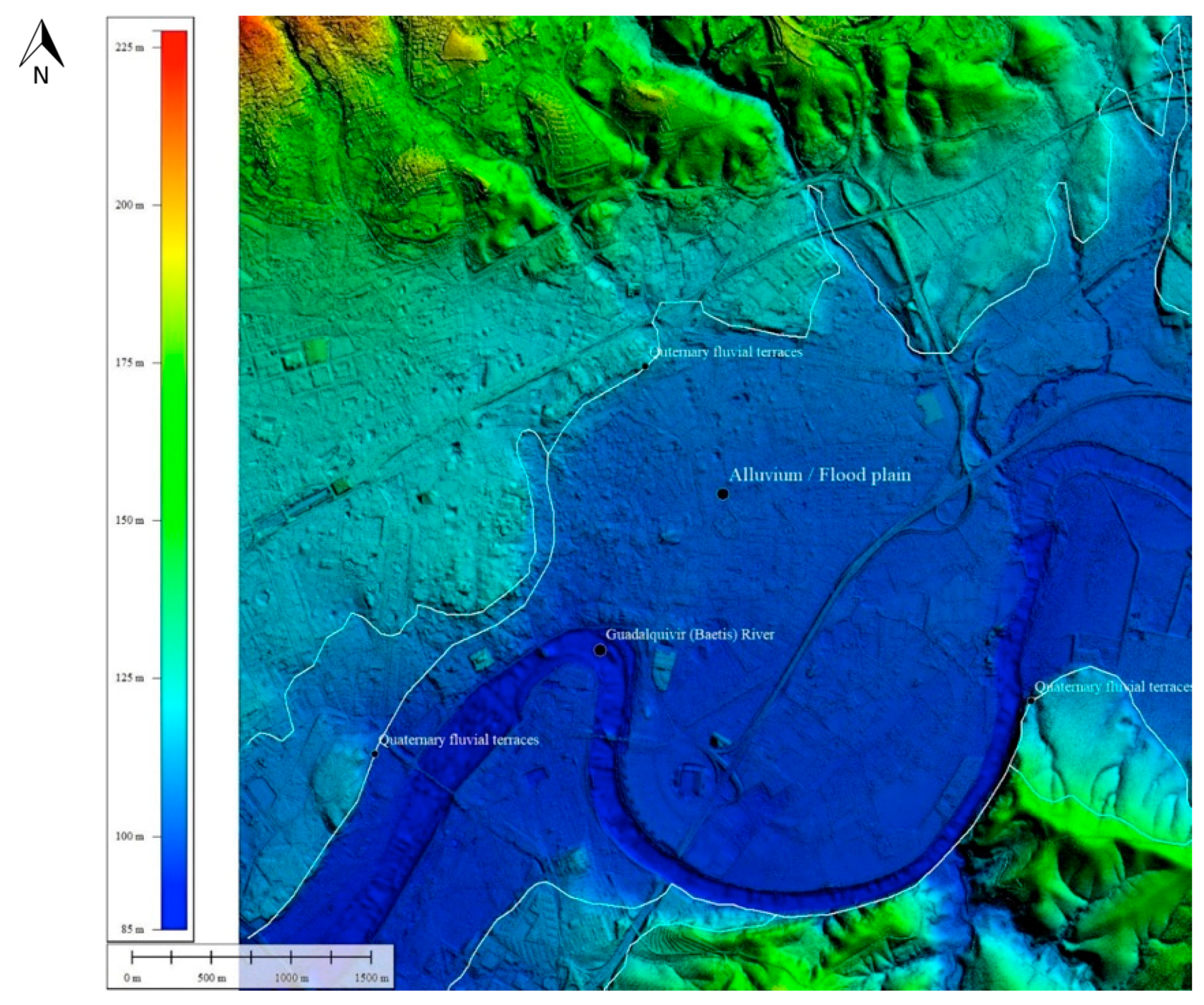
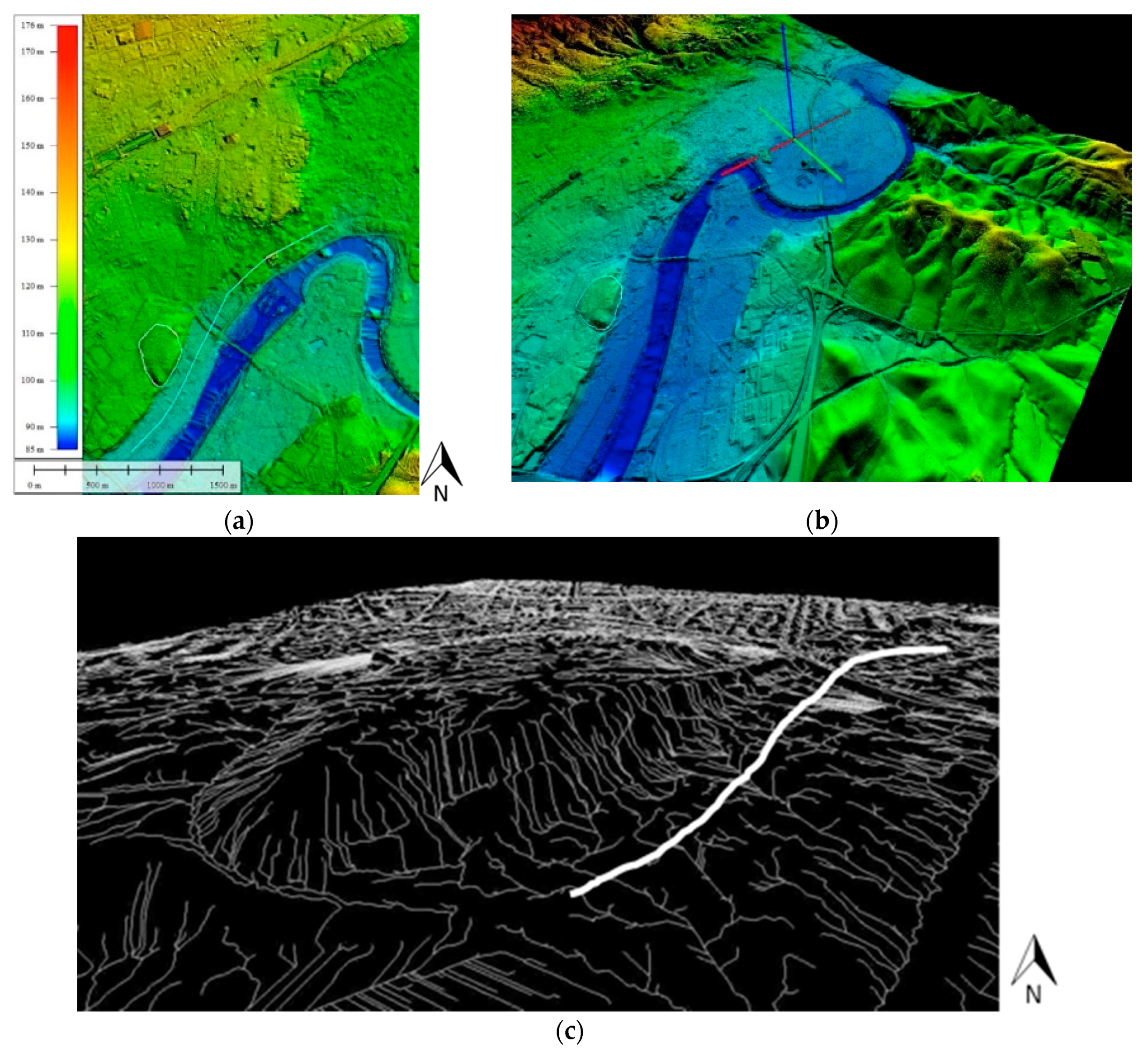
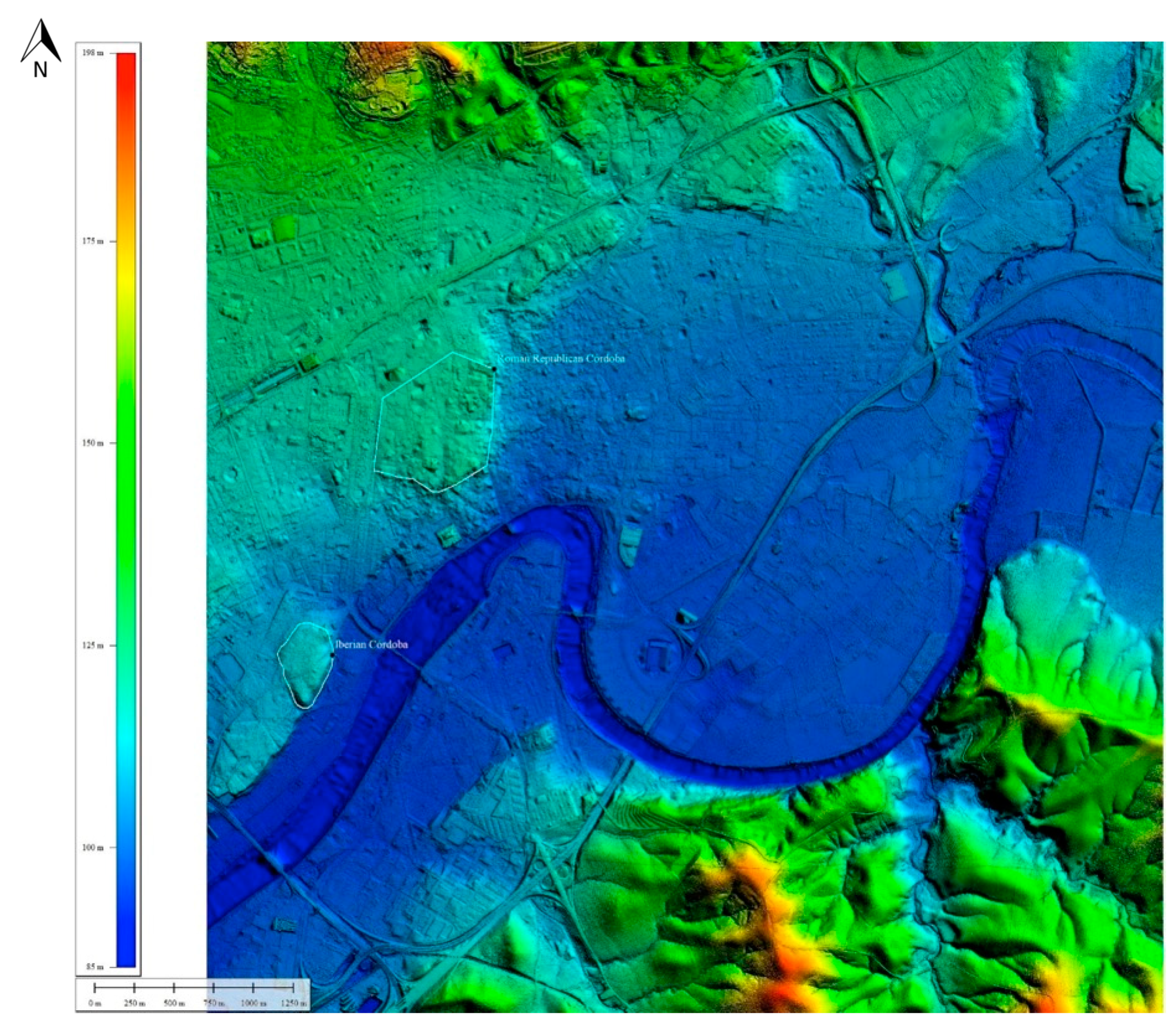
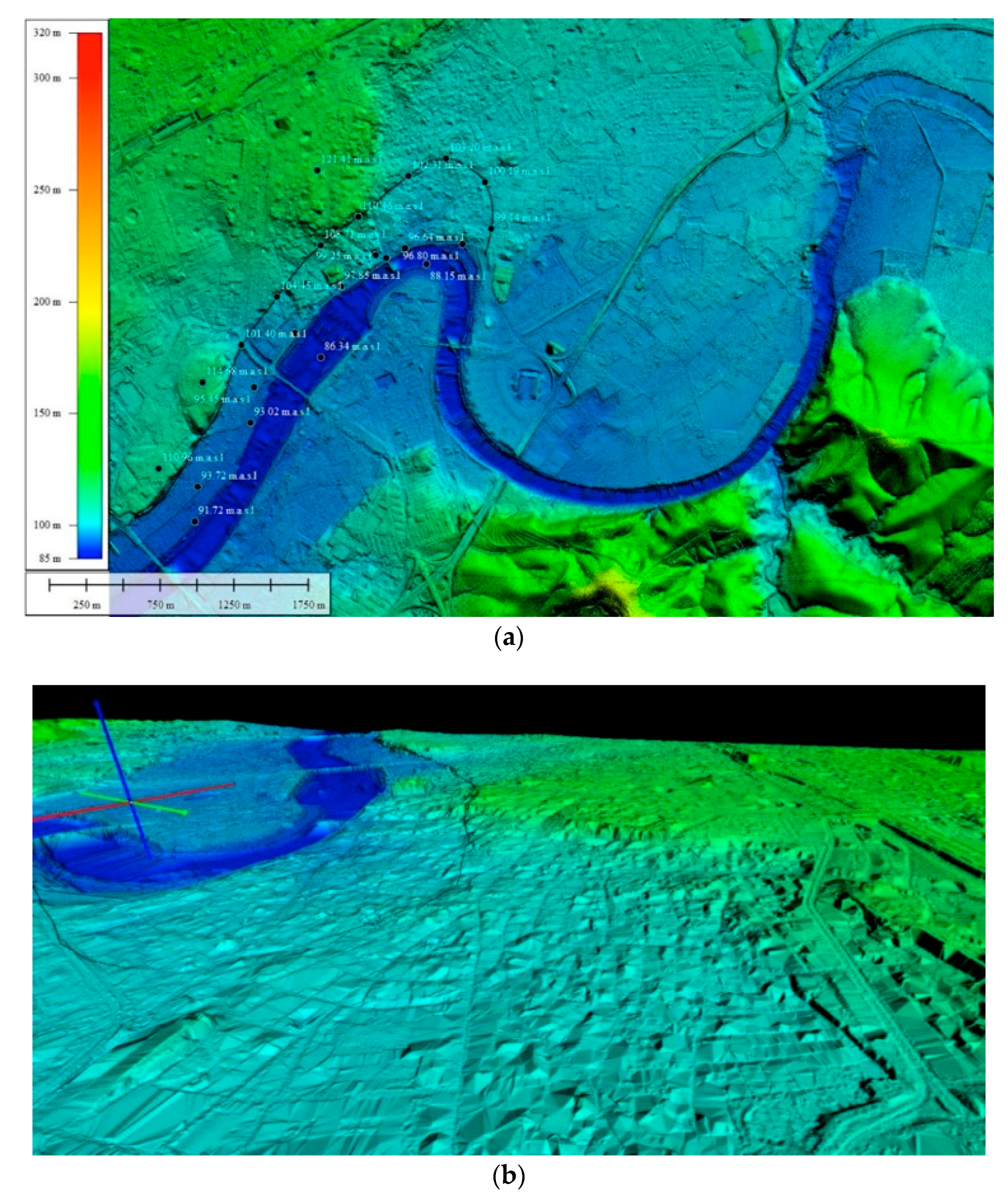
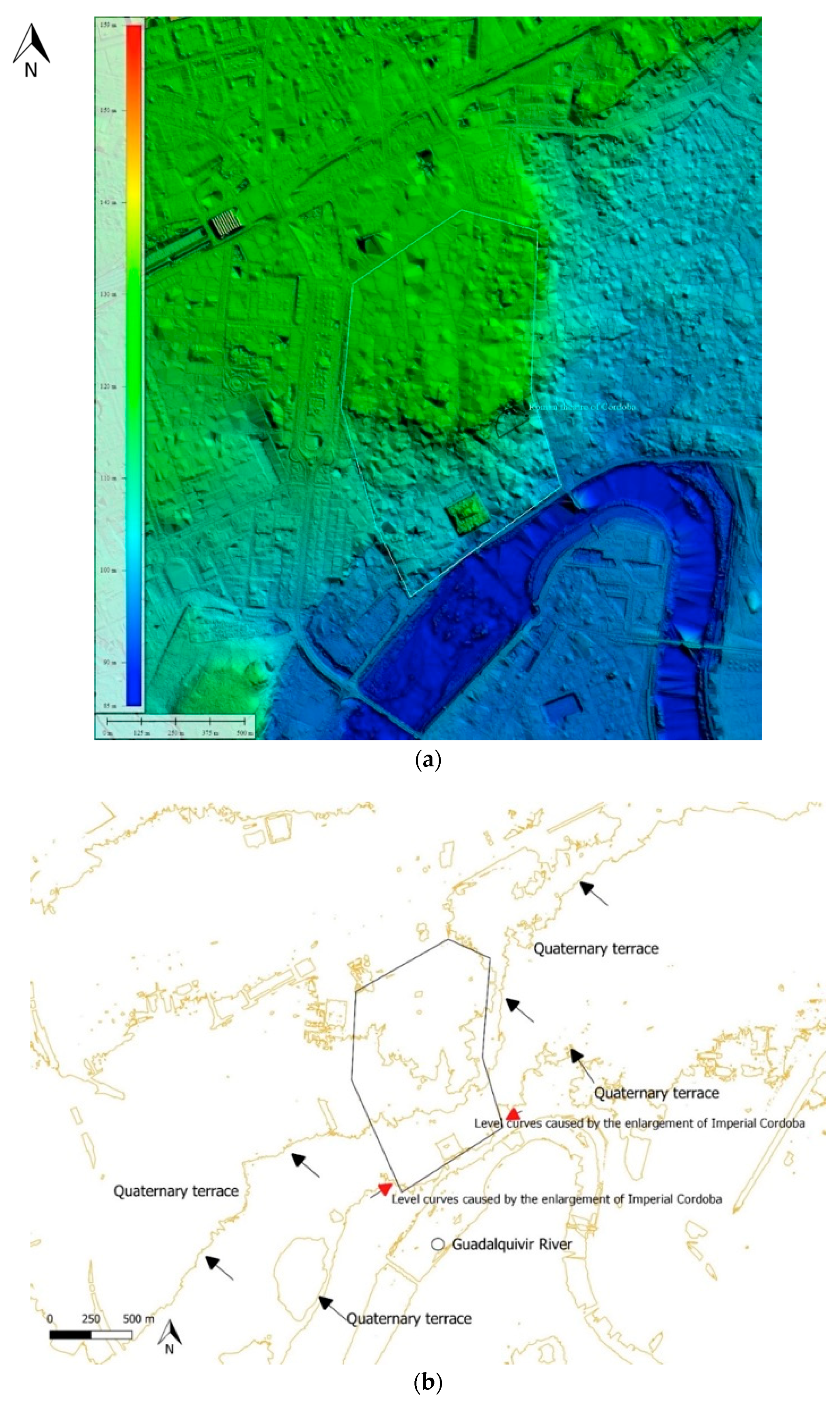
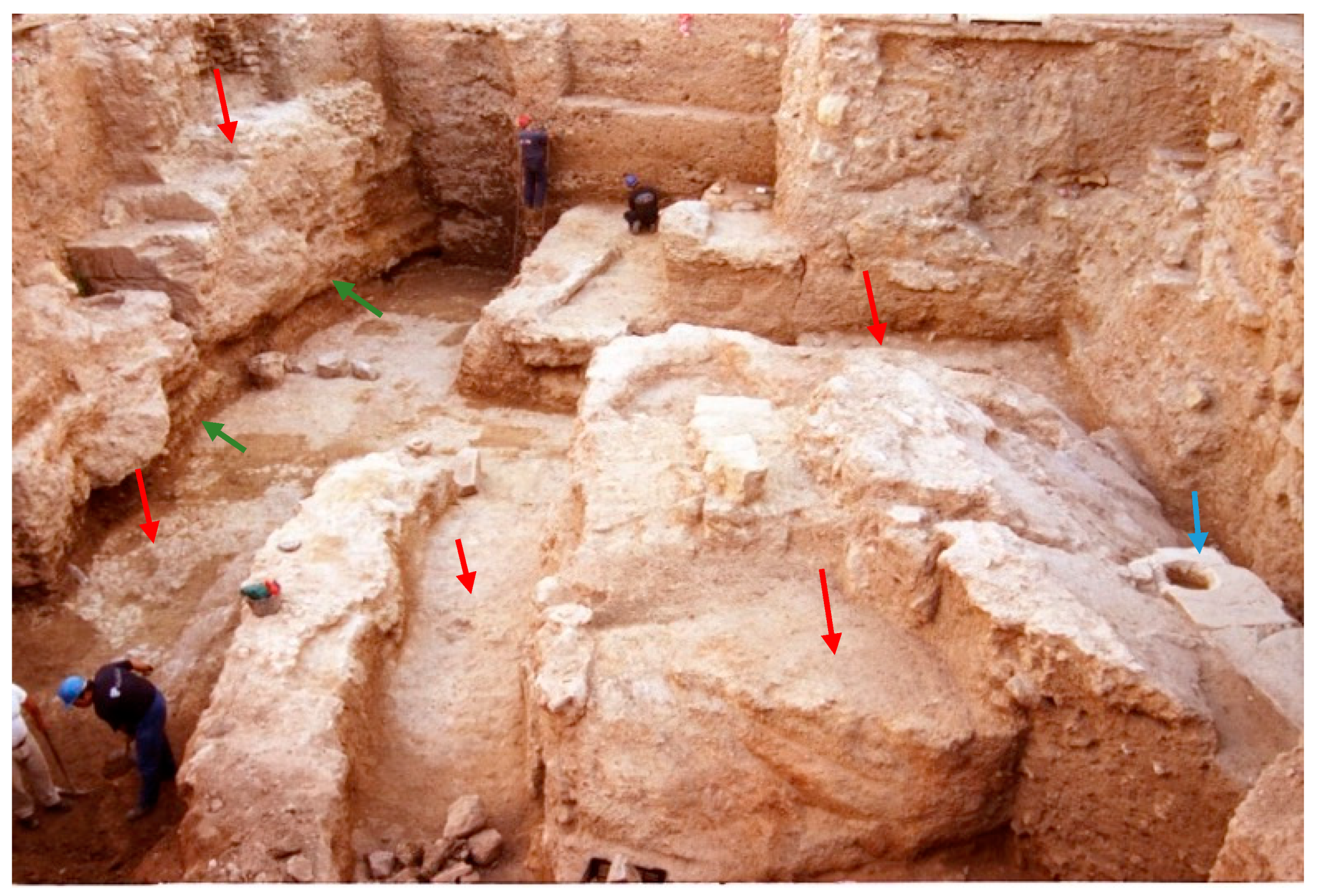
© 2019 by the author. Licensee MDPI, Basel, Switzerland. This article is an open access article distributed under the terms and conditions of the Creative Commons Attribution (CC BY) license (http://creativecommons.org/licenses/by/4.0/).
Share and Cite
Monterroso-Checa, A. Geoarchaeological Characterisation of Sites of Iberian and Roman Cordoba Using LiDAR Data Acquisitions. Geosciences 2019, 9, 205. https://doi.org/10.3390/geosciences9050205
Monterroso-Checa A. Geoarchaeological Characterisation of Sites of Iberian and Roman Cordoba Using LiDAR Data Acquisitions. Geosciences. 2019; 9(5):205. https://doi.org/10.3390/geosciences9050205
Chicago/Turabian StyleMonterroso-Checa, Antonio. 2019. "Geoarchaeological Characterisation of Sites of Iberian and Roman Cordoba Using LiDAR Data Acquisitions" Geosciences 9, no. 5: 205. https://doi.org/10.3390/geosciences9050205
APA StyleMonterroso-Checa, A. (2019). Geoarchaeological Characterisation of Sites of Iberian and Roman Cordoba Using LiDAR Data Acquisitions. Geosciences, 9(5), 205. https://doi.org/10.3390/geosciences9050205




